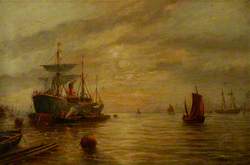How you can use this image
This image can be used for non-commercial research or private study purposes, and other UK exceptions to copyright permitted to users based in the United Kingdom under the Copyright, Designs and Patents Act 1988, as amended and revised. Any other type of use will need to be cleared with the rights holder(s).
Review the copyright credit lines that are located underneath the image, as these indicate who manages the copyright (©) within the artwork, and the photographic rights within the image.
The collection that owns the artwork may have more information on their own website about permitted uses and image licensing options.
Review our guidance pages which explain how you can reuse images, how to credit an image and how to find images in the public domain or with a Creative Commons licence available.
Notes
Add or edit a note on this artwork that only you can see. You can find notes again by going to the ‘Notes’ section of your account.
The two large black and white hulled ships in the centre are HMS 'Castor' in the foreground, and HMS 'Wellesley' behind. HMS 'Castor' was a naval training ship, permanently moored in the River Tyne. HMS 'Wellesley' was the renamed former battleship HMS 'Boscawen', and was home to boys who were being taught discipline and being prepared to take up the life of a seaman. This ship was destroyed by fire in 1914. On the far right hand edge can be seen the High Light (built in 1810), one of the two navigation aids at the mouth of the River Tyne, which is still there although no longer used for its original purpose. Bernard Benedict Hemy was born in Australia, where his family had emigrated in 1852, and was the youngest brother of noted British marine painters Charles Napier Hemy and Thomas Marie Madawaska Hemy.
Title
Fishing Fleet at North Shields, Tyne and Wear
Medium
oil on canvas
Measurements
H 100 x W 150 cm
Accession number
PCF4
Work type
Painting








